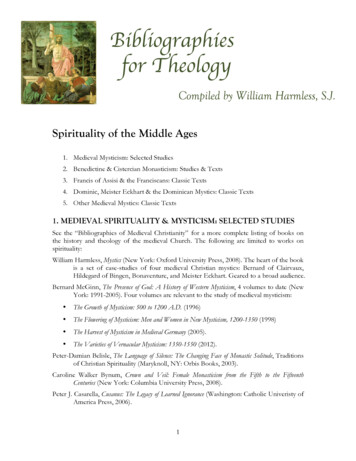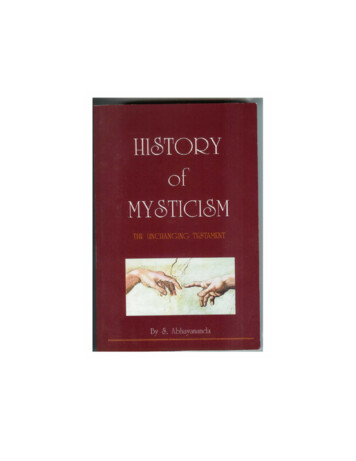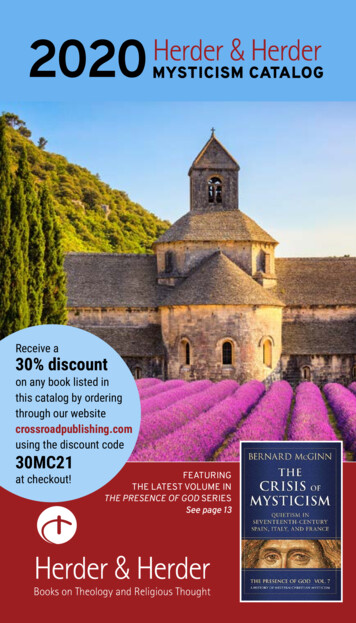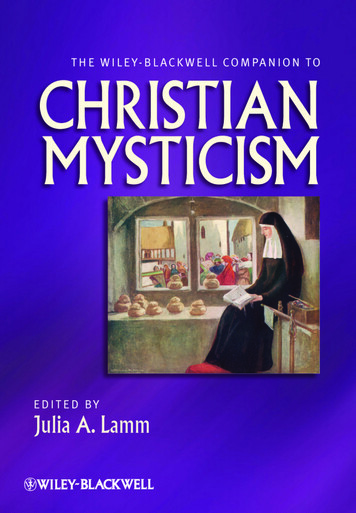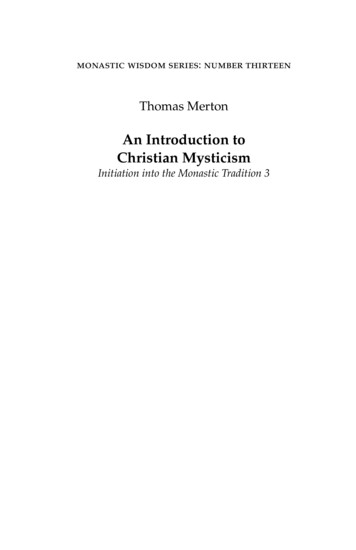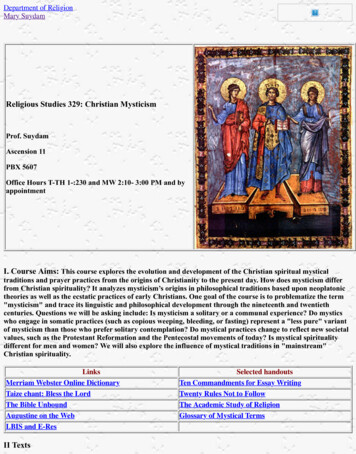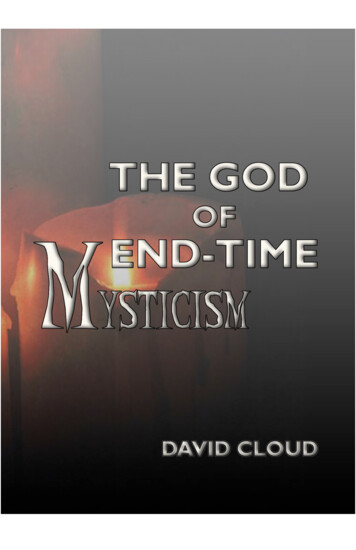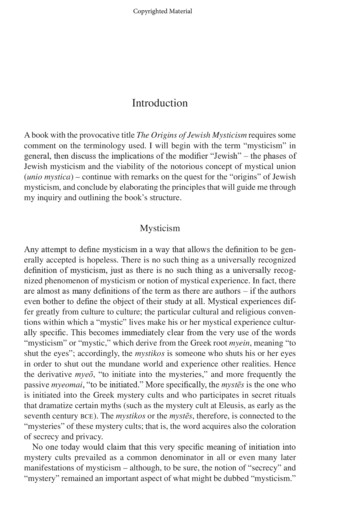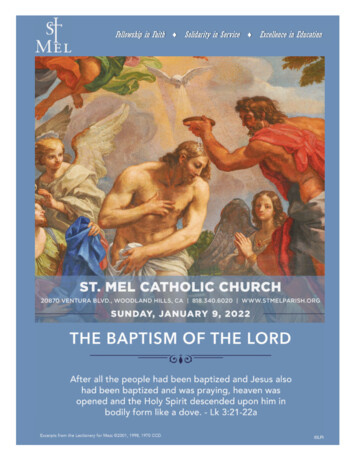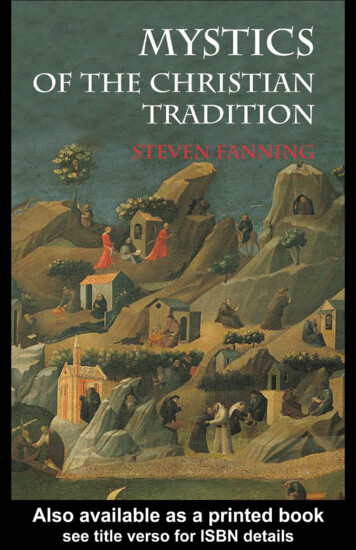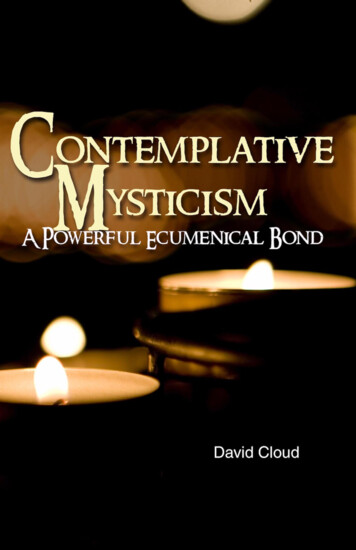
Transcription
Contemplative Mysticism: A Powerful Ecumenical BondCopyright 2008 by David W. CloudSecond edition November 2008This edition February 11, 2016ISBN 978-1-58318-113-3Published by Way of Life LiteratureP.O. Box 610368, Port Huron, MI 48061866-295-4143 (toll free) fbns@wayoflife.orghttp://www.wayoflife.orgCanada: Bethel Baptist Church,4212 Campbell St. N., London, Ont. N6P 1A6519-652-2619Printed in Canada byBethel Baptist Print Ministry2
ContentsWhat is Mysticism?.5A Definition of Mysticism .6The Taizé Approach.9Richard Foster: Evangelicalism’s Mystical Sparkplug .11The Widespread Influence of Mysticism .40Mysticism Is Found in All Branches of the EmergingChurch .40Mysticism Is Spreading Throughout Evangelicalism.45A Description of the Contemplative Practices .85Centering Prayer .85Visualization or Imaginative Prayer.91The Jesus Prayer .97The Breath Prayer.98Lectio Divina .99The Stations of the Cross .106The Mass.106The Labyrinth .113A Description of Roman Catholic Monasticism .115The Error of Roman Catholic Monasticism .125The Error of Contemplative Mysticism .157A Biographical Catalog of Contemplative Mystics .232Bibliography .455Index.4603
For additional books, ebooks, and videosthat address this subject and others see the“Bookstore”, “Free eBooks” and “Free eVideos”tabs at: www.wayoflife.org4
What is Mysticism?“There is intoxication in the waters of contemplation”Thomas Merton“Mysticism is no longer irrelevant; it is in the air we breathe”William JohnstonContemplative mysticism, which originated in the RomanCatholic monastic movement, is permeating every branch ofChristianity.Leonard Sweet says:“Mysticism, once cast to the sidelines of the Christiantradition, is now situated in postmodernist culture near thecenter. . In the words of one of the greatest theologians of thetwentieth century, Jesuit philosopher of religion/dogmatistKarl Rahner, ‘The Christian of tomorrow will be a mystic, onewho has experienced something, or he will benothing’” (Quantum Spirituality, 1991, pp. 11, 76).Ursula King observes that “recent years have seen a greaterinterest and fascination with the mystics of all ages and faiths thanany previous period in history” (Christian Mystics, p. 22).The Fruit of MysticismI will extensively develop this theme later in the book, but here Iwant to emphasize the fact that mysticism’s fruit is welldemonstrated and plainly unscriptural.Catholic mysticism leads inevitably to a broadmindedecumenical philosophy and to the adoption of heresies. For many,this path has led to interfaith dialogue, religious syncretism,universalism, pantheism (God is everything), panentheism (God isin everything), goddess theology, and the New Age.5
A Definition of MysticismI want to emphasize, first, what mysticism is not. It is not merelya desire to know Christ intimately and to be filled with the Spiritand to walk in God’s perfect will. It is not merely a life of worshipand devotion to God and fruitful Bible study. Mysticism goes farbeyond this.Mysticism, as we are using the term, is an attempt to communewith God experientially and to find spiritual understanding beyondthe pages of the Bible by means of Roman Catholic monasticpractices.Following are three characteristics of this mysticism:First, mysticism emphasizes a direct experience of God.Chamber’s Dictionary defines mysticism as “the habit ortendency of religious thought and feeling of those who seek directcommunion with God or the divine.”Leonard Sweet defines mysticism as an “experience with God” inthe metaphysical realm that is achieved through “mindbodyexperiences” (Quantum Spirituality, 1991, p. 11).Anthony de Mello says: “. we are, all of us, endowed with amystical mind and mystical heart, a faculty which makes it possiblefor us to know God directly, to grasp and intuit him in his verybeing.” (Sadhana: A Way to God, p. 29).Ursula King says, “Mystics seek participation in divine life,communion and union with God” (Christian Mystics, p. 4).Thomas Merton says:“Meditation is for those who are not satisfied with amerely objective and conceptual knowledge about life,about God--about ultimate realities. They want to enterinto an intimate contact with truth itself, withGod” (Spiritual Direction and Meditation, p. 53).Second, mysticism emphasizes finding spiritual insightbeyond thought and doctrine.It is focused on experience, feeling, emotion, intuition, andperception.Leonard Sweet says, “Mysticism begins in experience; it ends intheology” (Quantum Spirituality, 1991, p. 76).6
Anne Bancroft, author of Twentieth-Century Mystics and Sages,defined a mystic as someone who feels “a need to go beyond wordsand to experience the truth about themselves” (p. vii).Thomas Merton defined mysticism as an experience withwisdom and God apart from words.Anthony de Mello said:“The head is not a very good place for prayer. . You mustlearn to move out of the area of thinking and talking andmove into the area of feeling, sensing, loving,intuiting” (Sadhana: A Way to God, p. 17).“Contemplation for me is communication with God thatmakes a minimal use of words, images, and concepts ordispenses with words, images, and concepts altogether.This is the sort of prayer that John of the Cross speaks of inhis Dark Night of the Soul or the author of The Cloud ofUnknowing explains in his admirable book” (p. 29).Christianity Today says there are many young evangelicals whoare tired of “traditional Christianity” and want “a renewedencounter with God” that goes BEYOND “DOCTRINALDEFINITIONS” (“The Future Lies in the Past,” Christianity Today,Feb. 2008).This is a good definition of mysticism. It is an attempt toexperience God beyond the interpretation of Scripture, beyonddoctrine, beyond theology.Spencer Burke of the OOze says: “A move away fromintellectual Christianity is essential. We must move to themystical” (Emerging Churches, p. 230).Observe that he contrasts mysticism with the intellect.Mysticism tries to reach beyond that which can be understood withthe mind, beyond the teaching of Scripture.We realize that the believer does not grasp spiritual truths withhis intellect only, but the intellect should always be in gear, and thisis what the contemplative mystics renounce.Consider this description of centering prayer, which requiresputting aside conscious thoughts:7
“For in this darkness we experience an intuitiveunderstanding of everything material and spiritual withoutgiving special attention to anything in particular” (The Cloud ofUnknowing, chapter 68).This is pure mysticism, and The Cloud of Unknowing is aprimary resource for the contemplative movement.Tony Campolo describes contemplative spirituality as mysticalstillness and communing with God without words:“I get up in the morning a half hour before I have to andspend time in absolute stillness. I don’t ask God foranything. I just simply surrender to His presence and yieldto the Spirit flowing into my life. . An interviewer onceasked Mother Teresa, ‘When you pray, what do you say toGod?’ She said, ‘I don’t say anything. I just listen.’ So theinterviewer asked, ‘What does God say to you?’ Shereplied, ‘God doesn’t say anything. He listens.’ That’s thekind of prayer I do in the morning’” (Outreach Magazine,July/ August 2004, pp. 88, 89).Third, mysticism accepts extra-scriptural dreams and visionsand insights as revelations from God and, in fact, expects themas a natural product of the contemplative experience.Richard Foster says, “Christian meditation, very simply is theability to hear God’s voice and obey his word” (Celebration ofDiscipline, 1998, p. 17), and he is not talking here about hearingGod’s voice through Scripture alone.In the book Prayer: Finding the Heart’s True Home, Foster,quoting Thomas Merton, says that contemplative prayer “offersyou an understanding and light, which are like nothing you everfound in books or heard in sermons” (p. 160).The “spiritual insights” that the practitioner obtains throughcontemplative meditation becomes truth to him that is at leastequal in authority to Scripture.The Catholic “saints” who developed the contemplativepractices received countless extra-biblical revelations.This is the mystical approach that is fast becoming an acceptablemeans of “spirituality” in all branches of Christianity.8
The Taizé ApproachThe mystical movement is strongly influenced by Taizé(pronounced teh-zay). This is a religious community that wasformed in southeastern France during World War II by RogerSchutz, a Swiss Protestant pastor who went by the name of“Brother Roger” and who led the community until his death in2005. Its goal is to work for world peace and ecumenical unity.The Taizé monastic order includes some 100 allegedly “celibatebrothers” from different countries and denominations, includingRoman Catholic, Lutheran, Anglican, and Reformed.While the Taizé community itself is very small, the Taizéphilosophy has influenced churches throughout the world. Tens ofthousands of congregations in the U.S. and elsewhere hold Taizéprayer services and sing Taizé songs.Taizé is a major force for non-doctrinal ecumenism. Each yeartens of thousands of people make a pilgrimage to Taizé. Theseinclude Protestants, Baptists, Catholics, Jews, Buddhists, andothers. The Roman Catholic connection is very strong. Schutzparticipated in the Second Vatican Council, and Pope John Paul IIvisited Taizé in October 1986. In 2006, at John Paul II’s funeral,Schutz was given Eucharistic communion by the hands of JosephRatzinger, who a few days later became Pope Benedict XVI. SinceSchutz’s death (he was stabbed to death by a deranged womanduring a Taizé service), the organization has been led by a RomanCatholic priest named Alois Loeser.The Taizé services are non-dogmatic and non-authoritative.There is no preaching. “It does not dictate what people mustbelieve. No confessions of faith are required. No sermons aregiven. No emotional, evangelical-style testimonials are expected.Clergy are not required.” Schutz described the philosophy of Taizéas, “Searching together--not wanting to become spiritual masterswho impose; God never imposes. We want to love and listen, wewant simplicity” (“Taizé,” Religion and Ethics Newsweekly, Sept. 20,2002).Taizé’s non-doctrinal ecumenical Christianity is fueled bymysticism. A “shadowy medieval” atmosphere is created with theuse of such things as candles, icons, and incense (Vancouver Sun,April 14, 2000). The goal is to bring the “worshipper” into a9
meditative state, “to a place beyond words, a place of just being.”There is a lot of repetition, with “one-line Taizé harmoniesrepeated up to 15 times each.”Schutz taught that truth is found through mysticism. In 1995 hetold a group of 100,000 young people in Paris, “We have come hereto search, or to go on searching through silence and prayer, to getin touch with our inner life” (Brother Roger, 90, Dies,” New YorkTimes, Aug. 18, 2005).The Taizé philosophy is spreading quickly throughoutevangelicalism.10
Richard Foster: Evangelicalism’sMystical SparkplugRichard Foster’s writings have been at the forefront of thecontemplative movement since the 1970s. No one has done morethan this man to spread contemplative mysticism throughoutProtestant and Baptist churches.Foster’s book Celebration of Discipline, which has sold morethan two and a half million copies, was selected by ChristianityToday as one of the top ten books of the 20th century. (For thisreview I obtained multiple editions of Celebration of Discipline,plus three other books by Foster.)The Quaker ConnectionHe grew up among the Quakers (the Religious Society ofFriends), was trained at George Fox College, has pastored Quakerchurches, and has taught theology at Friends University inWichita, Kansas, and at George Fox. One website calls him“perhaps the best known Quaker in the world today.”The Quaker connection is important, because one of theirpeculiar doctrines is direct revelation via an “inner light.” This isdefined in a variety of ways, since Quakerism is very individualisticand non-creedal, but it refers to a divine presence and guidance inevery man. There is an emphasis on being still and silent andpassive in order to receive guidance from the inner light. Otherterms for it are “light of God,” “light of Christ,” “inward light,” “thelight,” “light within,” “Christ within,” and “spirit of Christ.”George Fox used the expression “that of God in everyone.” Inhis journal Fox said, “I was glad that I was commanded to turnpeople to that inward light, spirit, and grace, by which all mightknow their salvation, and their way to God; even that divine Spiritwhich would lead them into all Truth, and which I infallibly knewwould never deceive any” (The Journal of George Fox, revised byJohn Nickalls, 1952, p. 35).11
Another prominent Quaker, Robert Barclay, called this “thelight of the heart” and said “there is an evangelical and saving Lightand grace in all.”Isaac Pennington said, “There is that near you which will guideyou; Oh wait for it, and be sure ye keep to it.”Anne Riggs, a contemporary Quaker, says:“In silence which is active, the Inner Light begins togrow . a tiny spark. For the flame to be kindled and togrow, subtle argument and the clamor of our emotionsmust be stilled. It is by an attention full of love that weenable the Inner Light to blaze and illuminate our dwellingand to make of our whole being a source from which thisLight may shine out” (“The Religious Society of Friends(Quakers) as a Religious Community,” http://www.quaker.org/quest/issue1-3.html).Like Foster, Riggs is deeply associated with the contemplativemovement. She says that silent meditation kindles the “inner light”and produces revelation, but one must be careful not to test therevelations with “subtle argument.” This is blind mysticism and itwill inevitably lead to spiritual delusion.The inner light teaching is said to be based on John 1:9 -- “Thatwas the true Light, which lighteth every man that cometh into theworld.” Yet this verse does not say that there is a divine light inevery man. It merely says that Christ gives light to every man. Theepistle of Romans tells us more about this. There is the light ofcreation (Romans 1:20), the light of conscience (Romans 2:14-16),and the light of the Scripture (Romans 3:2). When men respond tothe light that they have, they are given more light (Acts 17:26-27).Because of the fall, man’s heart is darkened and foolish (Rom.1:21; Eph. 4:18).The inner light teaching was exalted above reliance on the Bible.Martin Meeker says, “. the early Quakers’ reliance on the Bible asa source of spiritual knowledge and inspiration was secondary totheir belief in the Inner Light as the primary path to salvation andcommunication with God” (The Doctrine of the Inner Light).George Fox would say to his listeners:“You will say, Christ saith this and the Apostles say this,but what canst thou say? Art thou a child of Light and hast12
thou walked in the Light, and what thou speakest, is itinwardly from God?”Fox claimed that he received the doctrine of the inner lightwithout help from the Scriptures (The Journal of George Fox,revised by John Nickalls, 1952, pp. 33-35).This is an unscriptural and very dangerous position that opensthe door for every sort of heresy. The Scripture is able to make theman of God perfect; obviously, then, nothing more is needed (2Timothy 3:16-17).The early Quakers misinterpreted 2 Corinthians 3:6, claimingthat the “letter” referred to the Scripture in general.“Along these lines, we might note that early Quakerstended to give an expansive reading of 2 Cor. 3:6, whichstates that God has made us ‘ministers of a new covenant,not of letter but of spirit; for the letter kills, but the Spiritgives life.’ This verse, if ‘letter’ is taken to mean ‘Scripture,’obviously places strong limits on the use of Scripture whileextending preference to Spirit, at the very least. One thus isnot surprised that it is a favorite of early Quakers,appearing as an allusion in the postscript of the Letterfrom the Elders of Balby, cherished by manycontemporary Friends” (Stephen Angell, “Opening theScriptures, Then and Now,” QUEST, Fall-Winter2007-2008).If the “letter” of 2 Corinthians 3:6 refers to the Scripture ingeneral, it would mean that Paul was exalting “the Spirit” above theScripture. It would mean that the Scripture is not the sole authorityfor faith and practice, but it is only one authority and that men arefree to follow their inner lights.This is a gross misinterpretation of the passage. In truth, 2Corinthians 3 contrasts the Law of Moses with the Gospel ofGrace, the Old Covenant with the New.2 Corinthians 3:7 leaves no doubt about this, which tells us thatthe “letter” that killeth is “the ministration of death, written andengraven in stones.” That refers, of course, to the Law of Mosesgiven on Mt. Sinai. It was a covenant of death because it requires offallen sinners what they cannot perform, which is perfect holiness.13
It was not given to provide a way of salvation but to show mentheir sinful, lost condition (Romans 3:19-20).To interpret the “letter” of 2 Corinthians 3:6 as a reference tothe Scripture in general also contradicts the fact that verse 11 saysthe “letter” has been “done away.” Obviously the Scripture has notbeen done away with, but the Law of Moses has. Its purpose was toact as a “schoolmaster” to lead men to Christ and once it performsthat glorious function its work is finished (Galatians 3:24-25).It is easy to see how the Quaker philosophy paved the way forFoster to accept Catholic mysticism. It did this by its emphasis onan “inner light” and its tendency not to judge things in an exactingmanner with the Bible.Other Quakers have followed the same path, and some, likeMary Conrow Coelho, have followed it all the way to the New Age.Conrow believes in evolution, the oneness of the universe, and theunity of man with God, and she traces her New Age mysticism todeep third generation Quaker roots and its inner light teaching:“The adults in our Quaker community spoke often of theInner Light, the seed of God, the indwelling Christ.[Thomas Kelly] said, ‘It is a Light within, a dynamic center,a creative Life that presses to birth within us’” (“OfLeadings and the Inner Light: Quakerism and the NewCosmology,” .(Richard Foster quotes Thomas Kelly favorably and frequentlyin his books, and the Renovaré Spiritual Formation Bible quotesKelly as saying: “Deep within us all there is an amazing innersanctuary of the soul, a holy place, a Divine Center.”)From its inception Quakerism was a heretical movement thatdownplayed the Bible and exalted personal revelation, and Foster isa product of that heresy even though he is on the “evangelical” sideof Quakerism.In this light it is not surprising to find him promoting RomanCatholic mystics who exalted their tradition and mysticalrevelations above the Scripture.14
Salvation Not ClearOne thing that is glaring in its absence from Foster’s books onspiritual living is a clear biblical testimony of salvation and a clearexhortation for his readers to be born again.When he does mention salvation, he speaks of it in a confusedmanner.He says, for example, that reconciliation has already beenachieved in Christ.“In some mysterious way, through shedding his bloodJesus took into himself all the evil and all the hostility of allthe ages and redeemed it. He reconciled us to God,restoring the infinitely valuable personal relationship thathad been shattered by sin” (Prayer: Finding the Heart’sTrue Home, p. 42).This is not true. Though the redemption price has been paid,sinners are not reconciled until they individually put their faith inthe gospel (John 3:16, 18, 36).Foster also speaks of salvation as a process.“One more thing is needed, namely, our response ofrepentance--not just once but again and again. MartinLuther declares that the life of the Christian should be oneof daily repentance” (Prayer, p. 42).We must understand that the previous statement is made in thecontext of a discussion of salvation. Foster makes no cleardistinction between the one repentance for salvation (Acts 17:30; 2Peter 3:9) and continual repentance for sanctification (2 Cor.12:21). Foster’s statement describes either universalism orsacramentalism, but it is not the once-for-all new birth doctrine ofthe New Testament.Further, Foster describes salvation in terms of an emotionalexperience and in association with baptism. In Prayer: Finding theHeart’s True Home, Foster tells of a non-Christian who attendedone of his contemplative seminars. Part way through the course thefollowing event transpired.“Throughout the weekend the Spirit of God rested tenderlyupon the entire group, so much so that on Sundayafternoon this same gentleman asked quietly, ‘Would you15
pray for me that I might know Jesus the way you knowJesus?’ What were we to do? None of the normal responsesseemed appropriate. We waited in silence. Finally oneyoung man stood up and gently placed his hands on theman’s shoulders. I have never forgotten his prayer. I feltlike taking off my shoes--we were on holy ground. Strangeas it may seem, he prayed a commercial. He described apopular advertisement of the day for NesTea in whichdifferent people, sweltering from the summer sun, wouldfall into a swimming pool with a thirst-quenching sense of‘ahhh!’ on their faces. He then invited this man to fall intothe arms of Jesus in the same way. The gentlemansuddenly began to weep, heaving deep sighs of sorrow andgrief. We watched in reverent wonder as he received thegift of saving faith. It was a tender, grace-filled moment.Later he shared with us how the prayer touched a deepcenter in his past relating to his baptism as a child” (pp. 48,49).While it is true that the Bible describes salvation in terms ofdrinking and eating of Jesus, the scene described by Foster isconfusing at best. What was this man trusting? What was hereceiving? He mentions his infant baptism. Had he come to believethat his baptism had brought him into a saving relationship withGod that he was only now learning to enjoy? What Jesus was hetrusting? What gospel? What was the nature of his faith? The Biblewarns that the devils believe in God. Only a certain kind of faith issaving faith. Foster doesn’t clarify any of this. His doctrine ofsalvation is exceedingly murky at best. When the unbeliever askedthe group to pray for him, why didn’t they share with him thegospel? They didn’t need to pray about what to say. They didn’tneed to hesitate. Jesus has already commanded us to preach thegospel to every creature (Mark 16:15). Why did they preach aNesTea commercial rather than the gospel?And while we are talking about Richard Foster and the gospel, ifhe believes the true gospel of the grace of Christ without works,why does he constantly and uninhibitedly promote Catholicmystics who hold to a sacramental gospel? If he doesn’t believeRome’s gospel of process salvation, why does he never warn aboutit plainly?16
Personal salvation is foundational to prayer and Christianliving. It is criminal to write books on these subjects for broadpublic consumption and not make salvation absolutely clear.Roman Catholic MysticismFoster advocates Roman Catholic mysticism with absolutely noqualms, building his contemplative practices unequivocally uponthis heretical foundation.He recommends Ignatius of Loyola, Francis of Assisi, Benedictof Nursia, Teresa of Avila, Catherine of Genoa, Julian of Norwich,Brother Lawrence, Dominic, Catherine of Siena, John of the Cross,the anonymous author of The Cloud of Unknowing, MadameGuyon, Thomas à Kempis, Catherine Doherty, Meister Eckhart,Thomas Aquinas, Hildegard of Bingen, Francis de Sales, Alphonsusde Liguori, Bernard of Clairvaux, John Henry Newman, PierreTeilhard de Chardin, G.K. Chesterton, André Louf, HenriNouwen, Dorothy Day, Karl Rahner, John Main, Mother Teresa,Thomas Merton, Brennan Manning, John Michael Talbot, andmany others.Foster’s recommendation of these Roman Catholic mystics isnot half-hearted. In the introduction to the 1998 edition ofCelebration of Discipline, he says that they taught him spiritualdepth and substance (pp. xiii, xiv), and he calls them “DevotionalMasters of the Christian faith.” Of the Spiritual Exercises ofIgnatius of Loyola, Foster says, “. it is a school of prayer for all ofus” (Prayer: Finding the Heart’s True Home, p. 59).There is no warning of the fact that these mystics trusted in aworks gospel, venerated Mary, worshipped Christ as a piece ofconsecrated bread, believed in purgatory, and scores of otherheresies. (For extensive documentation of this see the chapters “ADescription of Catholic Monastic Asceticism” and “A BiographicalCatalog of Contemplative Mystics.”)Bible Not Sole AuthorityLike his Roman Catholic friends, Foster’s foundational error isin not exalting the Bible as the sole authority for faith and practice.Nowhere in Celebration of Discipline or Prayer: Finding the Heart’s17
True Home does he instruct his readers that the Bible alone isGod’s infallible revelation and that everything must be carefullytested by it. This should be the very starting point for books onChristian spirituality and worship, but it is glaring in its absence.Foster encourages his readers to find revelation beyond Scripturethrough meditation, dreams, and personal prophecies.Foster describes how Francis of Assisi found spiritual guidance.When he was puzzled as to whether he should devote himselfexclusively to contemplative practices or also to engage inpreaching missions (which is plainly answered in Scripture), hesent word to two “trusted friends” and accepted their replies as thevery will of God. Foster says that Francis “was seeking a methodthat would open the gates of heaven to reveal the mind of Christ,and he took it as such” (Foster, Celebration of Discipline, 1978, pp.154, 155). Nowhere does Foster chide Francis of Assisi fordepending on the word of man rather than the Scripture.Neo-Orthodox Approach to ScriptureFoster’s approach to Scripture is a neo-orthodox, existentialistone. It is not by accident that he quotes Dietrich Bonhoefferfrequently and non-critically. (He also quotes the other two fathersof neo-orthodoxy, Karl Barth and Emil Brunner.)“This is not a time for technical word studies, or analysis,or even the gathering of material to share with others. .Dietrich Bonhoeffer said, ‘. just as you do not analyze thewords of someone you love, but accept them as they aresaid to you, accept the Word of Scripture and ponder it inyour heart, as Mary did. That is all. That ismeditation’” (Celebration of Discipline, 1978, p. 26).Yet the Bible is not merely a love letter. It is much more. It is theinfallible Word of God, and we are commanded to “analyze” it.“Study to shew thyself approved unto God, a workman that needethnot to be ashamed, rightly dividing the word of truth” (2 Tim. 2:15).Ken Silva of Apprising Ministries exposes the error of Foster’sapproach:The idea expressed above by Bonhoeffer of acceptingScripture subjectively as spoken to you is completely inline with the flawed view of the text of the Holy Scripture18
spread by neo-orthodox theologian Karl Barth. In neoorthodoxy the Scripture only becomes the Word of Godwhen the Holy Spirit illuminates it. We can sum up thiswrong idea this way: ‘The Bible is a divine mailbox inwhich we receive letters from Heaven.’ But no, it isn’t. TheBible itself--in full--is the letter, the message, from God.In his book Reckless Faith Dr. John MacArthur hits thetarget dead on as he shows why neo-orthodoxy is a perfectfit for contemplative mysticism as well as why it’s anecessity for it to flourish:‘Neo-orthodoxy is the term used to identify anexistentialist variety of Christianity. Because it denies theessential objective basis of truth--the absolute truth andauthority of Scripture--neo-orthodoxy must beunderstood as pseudo-Christianity. . Neo-orthodoxy’sattitude toward Scripture is a microcosm of the entireexistentialist philosophy: the Bible itself is not objectivelythe Word of God, but it becomes the Word of God when itspeaks to me individually. .‘Thus while neo-orthodox theologians often sound as ifthey are affirming traditional beliefs, . they relegate alltheology to the realm of subjective relativism. . Mysticismis perfectly suited for religious existentialism; indeed, it isthe inevitable consequence. The mystic disdains rationalunderstanding and seeks truth instead through thefeelings, the imagination, personal visions, inner voices,private illumination, or other purely subjectivemeans’ (MacArthur, Reckless Faith) (Ken Silva,“Contemplative Mysticism in the Southern BaptistConvention,” April 30, 2008, ative m.html).Instead of seeing the Scripture as divinely inspired andprofitable in every part as 2 Timothy 3:16-17 says, and thereforestudying it diligently in order to rightly
any previous period in history" (Christian Mystics, p. 22).!e Fruit of Mysticism I will extensively develop this theme later in the book, but here I want to emphasize the fact that mysticism's fruit is well demonstrated and plainly unscriptural. Catholic mysticism leads inevitably to a broadminded
